Ellis,J. Pressure transients in water engineering, A guide to analysis and interpretation of behaviour
Подождите немного. Документ загружается.

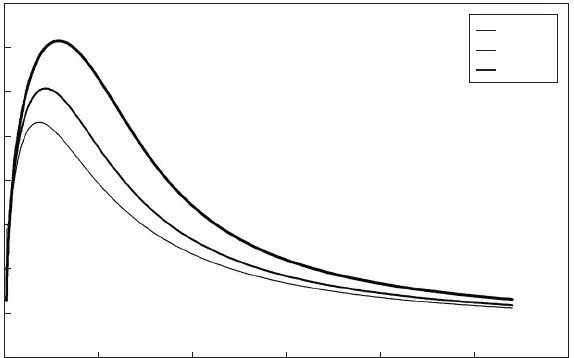
small gas pocket allows maximum reversed velocity to significantly
exceed the corresponding velocity when no gas pocket is present.
Pressure can rise quite quickly and the eventual peak pressure is greater
than that without an initial gas volume present. As the trapped gas
volume is changed from one computer simulation to the next, the
maximum pressure following flow reversal also varies. Maximum pressure
increases substantially with initial gas charge until 450 litres and there-
after diminishes gradually. For the same sample pipeline, Fig. 18.17
depicts the maximum predicted pressure as a function of initial gas
volume for polytropic coefficient values n ¼ 1:0, 1.2 and 1.4. With
each n value, a maximum pressure occurs and as gas volume is increased
beyond this peak the maximum pressure decreases gradually. The value
of n ¼ 1:0 produced the largest maximum pressure. Larger volumes
represent the region of pressure vessel solutions where the gas charge,
while allowing larger reversed velocities to occur, also provides a
substantial cushion so that a more gradual deceleration of flow can
occur thus reducing the maximum pressure. Pipeline resistance also
plays an increasing role as reversed velocity increases.
It might be expected that as air volume is gradually reduced, the
peak upsurge pressure would increase smoothly towards a peak value
corresponding to the situation with no gas volume present. Instead it
will be observed that peak upsurge pressure occurs with a finite and
342
n = 1.4
n = 1.2
n = 1.0
0 2 4 6 8 10 12
160
140
120
100
80
60
40
20
0
Initial air/
g
as volume
(
m
3
)
Maximum pressure head (mWG)
Fig. 18.17. Maximum head plotted against initial gas volume
Pressure transients in water engineering
relatively small initial gas volume and that this peak can be considerably
in excess of the maximum with no gas present.
The maximum amplification of 560% shown in Fig. 18.17 over the case
when no air pocket is present is greater by a factor of about 2 than the
260% amplification reported by Escarameia (2005) for an air pocket
located partway along a pipeline. Explanation for this difference may lie
in the position of the air pocket. The compression wave produced by
amplification of pressure at a point within the pipeline, will propagate
along the main. On encountering a closed valve for example, then
amplitude of the compression wave will be doubled against the valve,
resulting in an overall amplification of 520%. The 560% amplification
was for the case of an air pocket being compressed at a closed valve
while the 260% amplification was at a pocket along the pipeline.
18.6 Throttled outflow air valves
The use of throttled outflow air valves has been presented as a cost-
effective means of alleviating vacuum pressures. Chapter 17 described
use of a throttled outflow air valve to control upsurge pressures on
completion of subsequent air venting. Pressures occurring below a
throttled air valve, when a modest air pocket is compressed by reversed
flow, can be considered. It may be possible that a similar phenomenon of
pressure amplification could occur with a pocket of air beneath the air
release valve.
Computer simulations were carried out using the same hypothetical
pipeline illustrated in Fig. 18.16 but with an air valve sited at the start of
the pipeline. The initial head in the pipeline was set at atmospheric
pressure, 0.0 mWG. Flow was just reversing after an earlier downsurge
which has caused air to enter the pipeline. The effects of a range of
initial air volumes at the time of flow reversal were examined. Outflow
capacity of the throttled air valve was initially set to that of the small
orifice of the Glenfield APEX valve and the polytropic coefficient n
was set to 1.0. Under reversed flow the air mass will reduce in
volume both through compression and also by being vented to atmos-
phere. Small initial air volumes may be completely expelled during
the initial period of reversed flow while larger volumes are not fully
removed until subsequent cycles of oscillation. Pressure rise on air
valve closure was found to be relatively modest as shown in Fig. 18.18
with peak pressures mainly influenced by compression of the air mass.
If air outflow capacity is increased, for example to ten times the
APEX capacity, little air compression occurs and all air is removed
343
Air and gas
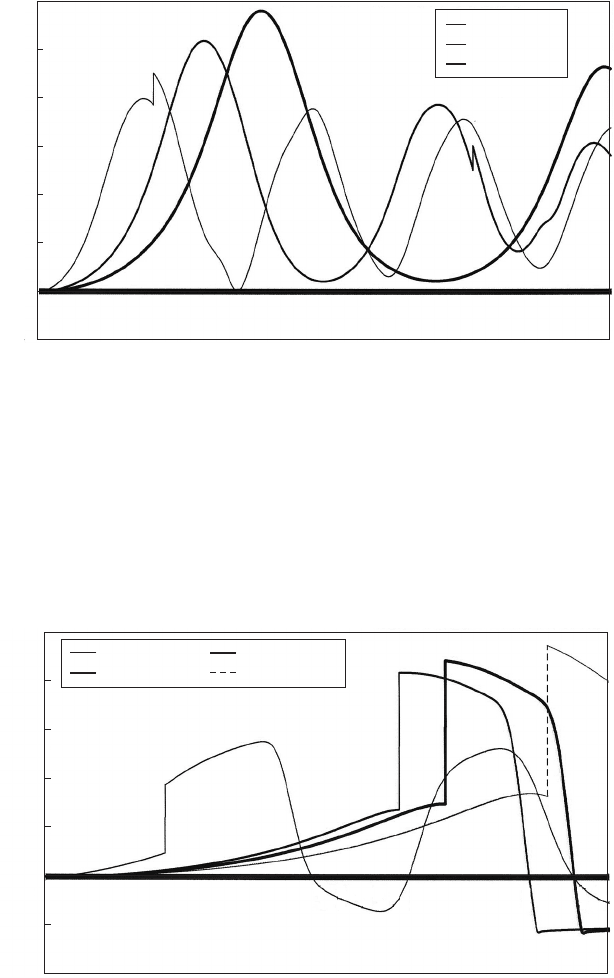
during the initial reversed flow interval. Figure 18.19 illustrates that the
pressure rise on valve closure is a more significant component of the
total pressure rise.
For the system under consideration these curves demonstrate that for
a given flow capacity, peak pressure is at a maximum for a particular
344
0.004
0.487
0.970
1.453
1.936
2.420
2.903
3.386
3.869
4.352
4.835
5.318
5.801
6.284
6.767
7.250
7.733
8.216
8.700
9.183
9.666
10.149
10.632
11.115
11.598
12.081
12.564
13.047
13.530
14.013
14.496
14.980
30
25
20
15
10
5
0
–5
Maximum pressure head (mWG)
Time (s)
Full open orifice
Vol = 10 litres
Vol = 40 litres
Vol = 80 litres
Fig. 18.18. Head plotted against time for small orifice valve
0.003
0.297
0.591
0.885
1.179
1.473
1.767
2.061
2.355
2.649
2.943
3.237
3.531
3.825
4.119
4.413
4.707
5.001
5.295
5.589
5.883
6.177
6.471
6.765
7.059
7.353
7.647
7.941
8.235
8.529
8.823
Pressure head (mWG)
Time (s)
n = 1.0
Vol = 10 litres Vol = 80 litres
Vol = 100 litres Vol = 150 litres
50
40
30
20
10
0
–10
–20
Fig. 18.19. Head plotted against time for larger outflow orifice
Pressure transients in water engineering
initial air volume and that the peak pressure increases as air flow
capacity rises.
18.7 Case study of a sewage rising main
In studying a pumping system a series of pressure transient modelling
exercises was carried out varying the amount of gas evolved under
transient low-pressure conditions. It was found that there is a band of
‘critical’ gas volume which produces a peak pressure noticeably in
excess of the pressures which are predicted when the gas mass is
assumed to be either smaller or greater than this critical range of
volumes. When transient pressures are allowed to range below atmos-
pheric pressure to the point at which gas can be released from sewage
it is recommended that caution be exercised in identifying the predicted
peak pressure. Possibly extremes could be identified by exploring the
influence of varying gas volume.
Potentially the existence of a relatively small pocket of air or gas
within a pipeline may produce an unexpectedly high peak transient
pressure. As an example, consider the case of Brown’s Point pumping
station and twin rising mains. The wet well/dry well arrangement
contains vertical risers with check valves located just downstream of
the pumps at the bottom of the risers (Figs 18.20 to 18.22). The
pumping mains rise continuously to the discharge point, passing
beneath Cullercoats metro station. Since the mains rise continuously,
no air valves were included as any air or gas would be expected to
migrate downstream to the outfall over time.
Pump start-up can be achieved without noticeable adverse effect
(Fig. 18.23).
After a pumping failure, piezometric level was predicted to fall below
the pipeline elevation at the pumping station and throughout the entire
system as shown in the envelope curves of Fig. 18.24. During the period
of sub-atmospheric pressure, evolution of gas from the sewage was
audible in the upper levels of the pumping station. After flow reversal,
loud noises and vibration occurred emanating from the pipework within
the pumping station. Recorded pressure versus time records at the
pumping station (Fig. 18.25) sometimes showed pressure peaks
around double the value of those which would normally have been
expected following pressure transient analysis. These peaks were attrib-
uted to the development of a gas pocket in the pipeline at the pumping
station during the initial downsurge after pump trip. Comparisons were
made between pressure recordings and predictions for a single main in
345
Air and gas
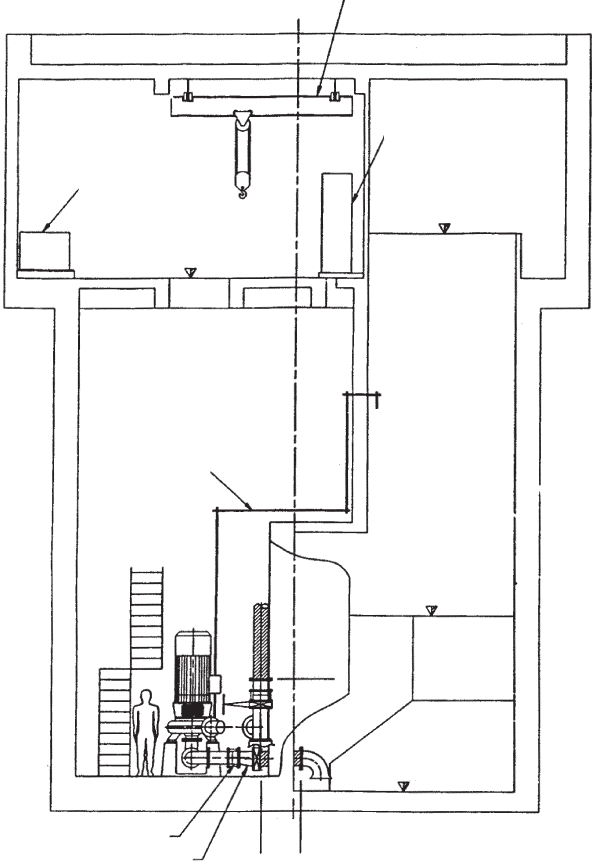
use and also with both mains in service. In each case two duty pumps
were tripped together. Figures 18.26 and 18.27 show these comparisons.
The precise volume of gas evolved is not possible to predict with any
accuracy nor is the rate of gas reabsorption with increasing pressure.
346
TP. 1
TP. 1
1.5 Tonnes crane (existing)
Washwater
booster set
Control panel
7.10
8.00
0.34
Air relief
(existing)
2500 N T.F.A.
300/2500 N T.F.A.
Part Section A–A
–3.20
TP. 2
Fig. 18.20. Wet well/dry well pumping station elevation
Pressure transients in water engineering
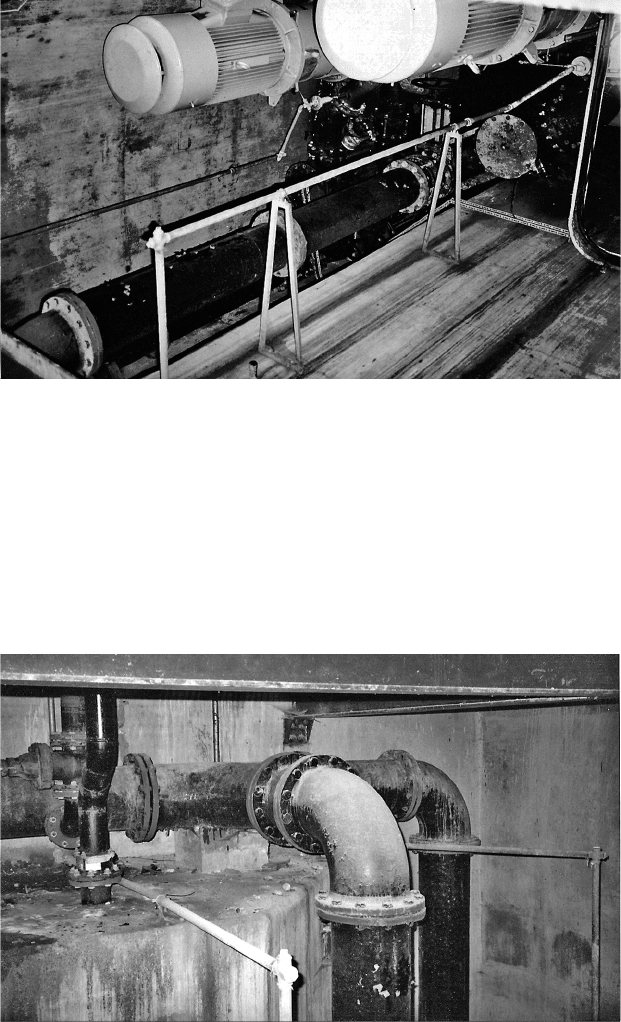
These parameters may vary to some extent from one test to another. A
modest increase in gas release rate is sufficient to produce a peak head
at the pumping station >100 m (Fig. 18.28).
The development of high pressures in the presence of a gas pocket is
essentially a matter of the time available to accelerate flow towards the
gas pocket. If the pocket is small then following flow reversal it does not
347
Fig. 18.21. Pumps, check valves and riser
Fig. 18.22. Pipework at top of riser
Air and gas
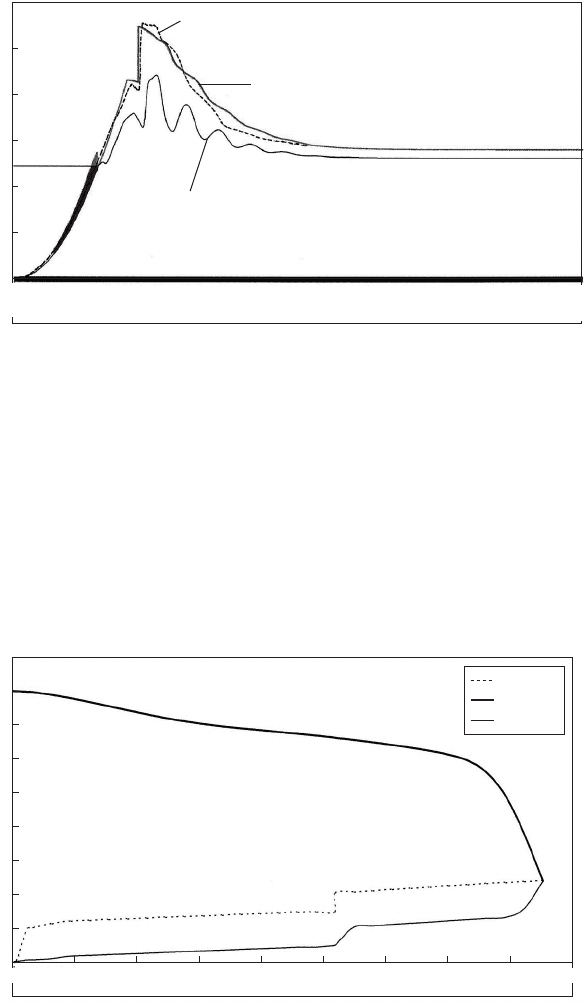
take long for the reversed flow to compress the gas and increase pressure
within the gas volume. As pressure increases, the hydraulic gradient
causing flow to accelerate towards the pocket is first flattened and
then starts to decelerate the reversed flow. If the time available to
accelerate flow is small then the maximum reversed velocity will also
be more limited and the peak upsurge pressure will tend to remain
more modest. As gas volume is increased, the rate of pressure rise in
348
60
50
40
30
20
10
0
–10
Head (mAOD)
Time (s)
Prediction halfway along rising mains
Observation d/s of pump
Prediction d/s of pump
0.008
0.815
1.621
2.428
3.234
4.040
4.847
5.653
6.460
7.266
8.072
8.879
9.685
10.492
11.298
12.104
12.911
13.717
14.524
15.330
16.136
16.943
17.749
18.556
19.362
20.168
20.975
21.781
22.588
23.394
24.200
25.007
Fig. 18.23. Head variations on pump start
90
80
70
60
50
40
30
20
10
0
–10
Chaina
g
e (m)
Brown’s Point/two pump trip/solo main/0.0008 ¥ 0.2 ¥ 0.2
i.l. mAOD
H
max-m
H
min-m
Elevation (mAOD)
0 100 200 300 400 500 600 700 800 900
Fig. 18.24. Envelope curves on pump failure
Pressure transients in water engineering
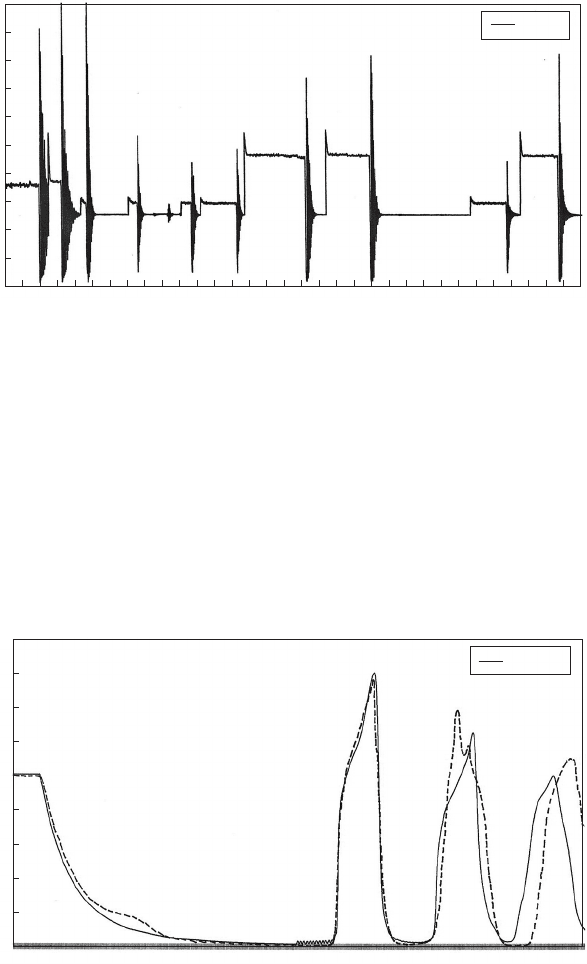
the gas pocket becomes smaller and the hydraulic gradient accelerating
flow persists for longer, allowing a larger reversed velocity to develop.
The gas mass is still not sufficient to effectively cushion the reversed
flow and with compression of the gas mass, pressure rises increasingly
349
07/22/99 14:29:52
07/22/99 14:31:48
07/22/99 14:33:45
07/22/99 14:35:41
07/22/99 14:37:37
07/22/99 14:47:41
07/22/99 14:49:38
07/22/99 14:51:34
07/22/99 14:53:30
07/22/99 14:55:44
07/22/99 14:59:15
07/22/99 15:01:12
07/22/99 15:03:08
07/22/99 15:05:04
07/22/99 15:07:02
07/22/99 15:08:58
07/22/99 15:10:54
07/22/99 15:12:51
07/22/99 15:14:47
07/22/99 15:21:38
07/22/99 15:23:34
07/22/99 15:25:31
07/22/99 15:27:27
07/22/99 15:29:23
07/22/99 15:31:19
07/22/99 15:33:16
07/22/99 15:35:12
07/22/99 15:37:15
07/22/99 15:39:12
07/22/99 15:41:08
07/22/99 15:43:08
07/22/99 15:45:04
07/22/99 15:47:01
07/22/99 15:48:57
10
9
8
7
6
5
4
3
2
1
0
Time
bar (g)
Pressure (bar g)
Fig. 18.25. Recorded pressure variations during pu mp start/stop operations
0.027
0.729
1.431
2.133
2.835
3.537
4.239
4.941
5.643
6.345
7.047
7.749
8.451
9.153
9.855
10.557
11.259
11.961
12.663
13.365
14.067
14.769
15.471
16.173
16.875
17.577
18.279
18.981
19.683
20.385
21.087
Brown’s Point/two pump trip/solo main/0.0008 ¥ 0.2 ¥ 0.2
Time
(
s
)
PS head
Head (mAOD)
90
80
70
60
50
40
30
20
10
0
Fig. 18.26. Trip of two pumps, comparison of head variations
Air and gas
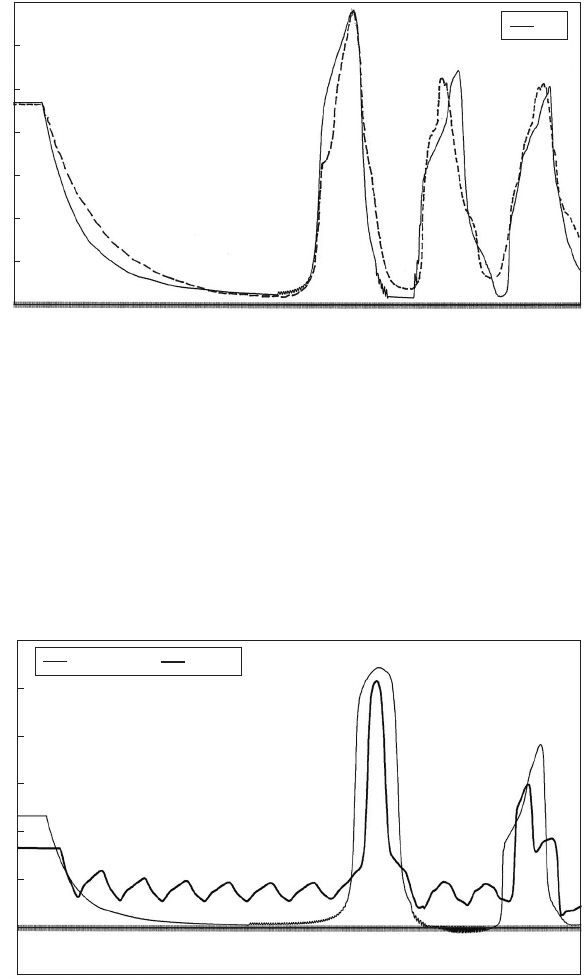
steeply to produce the peak pressure. With a large gas pocket there is
ample time to create the maximum reversed velocity. Eventually the
hydraulic gradient flattens and flow starts to decelerate. Gas volume
remains relatively large and rate of pressure rise is modest, producing
a gradual deceleration of flow and a lower peak. With such relatively
350
Brown’s Point/two pump trip/two mains in use/0.001 ¥ 0.2 ¥ 0.2
PS
0.027
0.675
1.323
1.971
2.619
3.267
3.915
4.563
5.211
5.859
6.507
7.155
7.803
8.451
9.099
9.747
10.395
11.043
11.691
12.339
12.987
13.635
14.283
14.931
15.579
16.227
16.875
17.523
18.171
18.819
19.467
Time (s)
Head (mAOD)
70
60
50
40
30
20
10
0
Fig. 18.27. Trip of two pumps, comparison of head variations
Brown’s Point/two pump trip/two mains in use/0.004 ¥ 0.2 ¥ 0.2
head – PS mid-pt
Time (s)
Head (mAOD)
0.027
0.675
1.323
1.971
2.619
3.267
3.915
4.563
5.211
5.859
6.507
7.155
7.803
8.451
9.099
9.747
10.395
11.043
11.691
12.339
12.987
13.635
14.283
14.931
15.579
16.227
16.875
17.523
18.171
18.819
19.467
120
100
80
60
40
20
0
–20
Fig. 18.28. Predicted head variations for increased gas release
Pressure transients in water engineering
large volumes, behaviour is similar to that which occurs in the presence
of a pressure vessel.
In these instances where the amounts of gas present are uncertain it is
prudent to consider the effects of this uncertainty by exploring sensitivity
of predictions to possible variations in gas volume. This is important as
these computations are approximate given the uncertainties surrounding
amounts of gas evolution and its subsequent behaviour.
18.8 Pump blockage
A further instance where air in a pipeline can lead to high transient
pressures is when a pump blockage occurs. Recorded pressure versus
time histories in the riser of the submersible pump installation consid-
ered earlier in this chapter revealed peak transient pressures reaching
20 bar(g). These pressures were neither associated with pump start
nor with pump trip, but occurred during pump operation. It was
surmised that temporary blockage of the operating pump could be
responsible, as considerable quantities of sediment and other material
entered the wet well after system commissioning.
Computations were carried out to determine if pump blockage could
account for the high pressures observed. The blockage was represented
as a rapid drop in pump speed with the impeller ceasing to rotate.
Pressure in the riser also decreased sharply, allowing flow into the down-
stream system to stop and the non-return valve to close. Flow passages
within the pump allowed sewage to drain from the riser, with the air
valve upstream of the check valve opening to allow air inflow. The
rate at which the riser drained back into the wet well and also the dura-
tion of the blockage could obviously vary from one occasion to another.
To illustrate events, a short duration of blockage lasting 2 s was chosen
with a reversed velocity into the wet well through the stationary pump
impeller of around 0.3 m/s.
The blockage was assumed to clear after 2 s, allowing the pump to
quickly accelerate to its design speed.
Figure 18.29 shows the predicted head variation at the pump and at
the top of the riser. After the blockage occurs, head at the pump
delivery falls towards the prevailing sewage level in the wet well. In
the riser a steep drop in head occurs and this is stabilised by operation
of the air valve. Two seconds after the blockage occurred, the pump
resumed operation and head at the pump rose to a peak and then
dropped back to some extent. Head at the top of the riser increased
and a modest oscillation developed. At around 2.9 s the air valve
351
Air and gas
